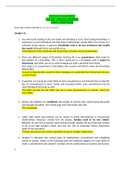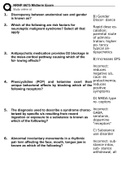Psy 357 study guide - Study guides, Class notes & Summaries
Looking for the best study guides, study notes and summaries about Psy 357 study guide? On this page you'll find 6 study documents about Psy 357 study guide.
All 6 results
Sort by

-
PSY 357, Lifespan Development Study Guide #1 Exam Questions and Answers 2024
- Exam (elaborations) • 14 pages • 2024
- Available in package deal
-
- $13.49
- + learn more
How do nature and nurture contribute to developmental changes? - Nature= genetic traits inherited from our parents and grandparents, while nurture= different environmental factors that have influenced brain development over the years. Physical Development - development involving the body's physical makeup, including the brain, nervous system, muscles, and senses, and the need for food, drink, and sleep Lifelong development - In the life-span perspective, early adulthood is not the endpoin...

-
Psy 357 - Study Guide Quiz 1 (Viorela Monk) GCU Exam Guide 2024
- Exam (elaborations) • 10 pages • 2024
- Available in package deal
-
- $13.49
- + learn more
Define human development. - The multidisciplinary study of how people change and how they remain the same over time. What does human development research examine? - What recurring issues of development have scholars addressed throughout history? What are the basic forces in the biopsychosocial framework? How does the timing of these forces make a difference in their impact? How does neuroscience enhance understanding of human development? This is the difference between nature vs....

-
PSY 357 LIFESPAN EXAM -PSY 357 Study Guide Exam 3: Grand Canyon University
- Exam (elaborations) • 8 pages • 2022
-
- $10.05
- + learn more
GRAND CANYON UNIVERSITY PSY 357 | PSY357: LIFESPAN EXAM 3: STUDY GUIDE EXAM WILL COVER CHAPTERS 11, 12, 13, 14, 15 & 16 Chapter 11: 1. You will recall reading in the text book and listening in class, that having friendships is important to most individuals but that these relationships usually differ from those of a romantic loving nature. In general, friendships tend to be less emotional and usually less sexual although these can and do occur. Friendships are less emotional and sexua...

-
NRNP 6675 Midterm Exam
- Exam (elaborations) • 145 pages • 2023
-
- $15.49
- + learn more
1. Discrepancy between anatomical sex and gender is known as? 2. Which of the following are risk factors for neuroleptic malignant syndrome? Select all that apply 3. Antipsychotic medication provides D2 blockage in the meso-coritcal pathway causing which of the fol- lowing effects? 4. Phencyclidine (PCP) and ketamine exert their unique behavioral effects by blocking which of the following receptors? 5. The diagnosis used to describe a syndrome charac- terized by specific s/s resultin...

-
GCU-PSY-357 Lifespan Development Study Guide-Development Through the Lifespan 7ED Laura Berk CH5
- Exam (elaborations) • 12 pages • 2021
-
- $10.49
- + learn more
How humans develop and change over time a. Physically b. Cognitively c. Socially1. How humans develop and change over time a. Physically b. Cognitively c. Socially 2. Influences on development: a. Nature vs. Nurture 3. Maturation: biologically determined changes that follow an orderly sequence Developmental issues: 2 fields of thought 1. Stages or Continuous Change? a. Stages: development through discrete stepsthrough which everyone progressesin same sequence 2. Continuity: development issteady ...

-
GCU-PSY-357 Lifespan Development Study Guide-Development Through the Lifespan 7ED Laura Berk CH5
- Exam (elaborations) • 12 pages • 2021
-
- $10.99
- + learn more
How humans develop and change over time a. Physically b. Cognitively c. Socially1. How humans develop and change over time a. Physically b. Cognitively c. Socially 2. Influences on development: a. Nature vs. Nurture 3. Maturation: biologically determined changes that follow an orderly sequence Developmental issues: 2 fields of thought 1. Stages or Continuous Change? a. Stages: development through discrete stepsthrough which everyone progressesin same sequence 2. Continuity: development issteady ...

How did he do that? By selling his study resources on Stuvia. Try it yourself! Discover all about earning on Stuvia


